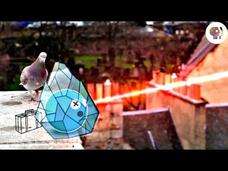Curated Video
The Evolution of Optical Media
Optical media, such as CDs, DVDs, and Blu-ray discs, encode data as binary code and are read by lasers. We explore how these discs work and the impact they have had on music and video distribution. Additionally, we discuss the emergence...
Curated Video
The Fascinating World of Helium
This video provides a comprehensive overview of helium, covering its properties, discovery, and various applications. It explains how helium's unique characteristics make it ideal for cryogenic purposes, such as preserving food and...
Physics Girl
How does laser cooling work?
Lasers are known to burn things, fix eyes, and dance on powerpoint presentations. But they can also be used to cool objects to some of the coldest temperatures in the universe.
Next Animation Studio
NASA to use lasers for space communication
NASA has announced that it is building a new satellite dish as part of the Deep Space Network that would be able to communicate with far away robotic spacecrafts.
Science ABC
Can We Harness Electricity From Lightning?
It is very difficult to harness power from lightning power because of its volatile nature, sporadic appearance and uneven geographical distribution. Lightning is one of the incredible forces of nature. A single bolt of it carries a few...
Curated Video
The Fascinating Uses of Neon
In this video, we learn about the element neon and its significance in the periodic table. Despite its classification in the "sad" group of the periodic table, neon holds great value. The video highlights its use in electric lights,...
Science360
Biophotonics poised to make major breakthroughs in medicine
Imagine having the ability to manipulate light waves in order to see through a skull right into the brain, or being able to use lasers to diagnose a bacterial infection in a matter of minutes. At the Center for Biophotonic Sensors and...
Press Association
Grant Shapps visit defence laboratory in Porton Down
Defence Secretary Grant Shapps visits Porton Down military research hub in Salisbury. A new British military laser could be rushed on to the front line in Ukraine to take down Russian drones.
British Movietone
NEW LIGHT ON TOMORROW
The newest form of light, the Laser beam, made by passing ordinary light through a ruby, has proved to be an amazing source of new power. Though still in its early days, it is already being used in industry, for precision measuring, for...
Curated Video
Engineers compete and test the potential reality of the science fiction concept of space elevators. The AP's John Mone on why leaving the Earth, may not require rocket science
HEADLINE: First floor Earth; second floor space
CAPTION: Engineers compete and test the potential reality of the science fiction concept of space elevators. The AP's John Mone on why leaving the Earth, may not require rocket science....
Bloomberg
Apple Makes Headway in Secret Bid to Track Glucose on Watch
Bloomberg's Mark Gurman joins Caroline Hyde to discuss Apple's moonshot-style project dating back to the Steve Jobs era: noninvasive and continuous blood glucose monitoring.
Curated Video
Why Is There New Interest In Fusion Energy?
A company by the name of Zap Energy is trying to find a way to develop more energy output from fusion reactions.
Teen Kids News
Animation Careers: How to Make an Animated Cartoon
The art of animation is a lot older than you think. Walt Disney might have brought it to the masses in the 1920s, but the first projected animation came courtesy of a machine called the magic lantern invented way back in 1650.
Scholastic
Study Jams! Light
Let there be light in your classroom with a video that explains that light travels in waves, the electromagnetic spectrum contains seven colors, and the color of an object depends on which light waves it reflects and absorbs. With...
TED-Ed
How Does Laser Eye Surgery Work?
Everything you wanted to know about laser vision correction surgery but was afraid to ask; can be found in a short animated video. While highly technical, the animations that accompany the narration, make the surgery easy to understand....
TED-Ed
How Do Self-Driving Cars “See”?
What do you get when you mix LiDAR and integrated photonics technology? Why a self-driving car, of course. A fascinating short video describes how light detection and ranging, LiDAR for short, and integrated photonics technologies enable...
Veritasium
Science of Laser Hair Removal in SLOW MOTION
Lasers attack hair cells from the outside in. Young scholars observe a laser hair treatment in slow motion. They watch as the pulses of the laser destroy the external hair. The Veritasium instructor then describes the process happening...
Physics Girl
Why Do We Care about Gravitational Waves?
Advances in technology lead to advances in science. As part of a larger playlist on physics, the video presenter explains the history of the discovery of gravitational waves. Using these waves provides insight into many different...
Physics Girl
How Does Laser Cooling Work?
We typically think of lasers adding heat energy, but lasers can be used for cooling, too! An episode of a physics playlist discusses the science of lasers. Learners watch how to place lasers to effectively slow subatomic particles.
American Chemical Society
Nerding out on Star Wars Science
Are light sabers possible? Could the Death Star really vaporize a planet the size of Earth? Take a look at the science behind the fiction with a video from the American Chemical Society's Reactions series. Physicists sound off on the...
MinutePhysics
How Lasers Work (In Theory)
Show laser focus through an engaging video lesson that explains the design of a laser. It includes an explanation of the behavior of photons as they work together to produce the laser.







